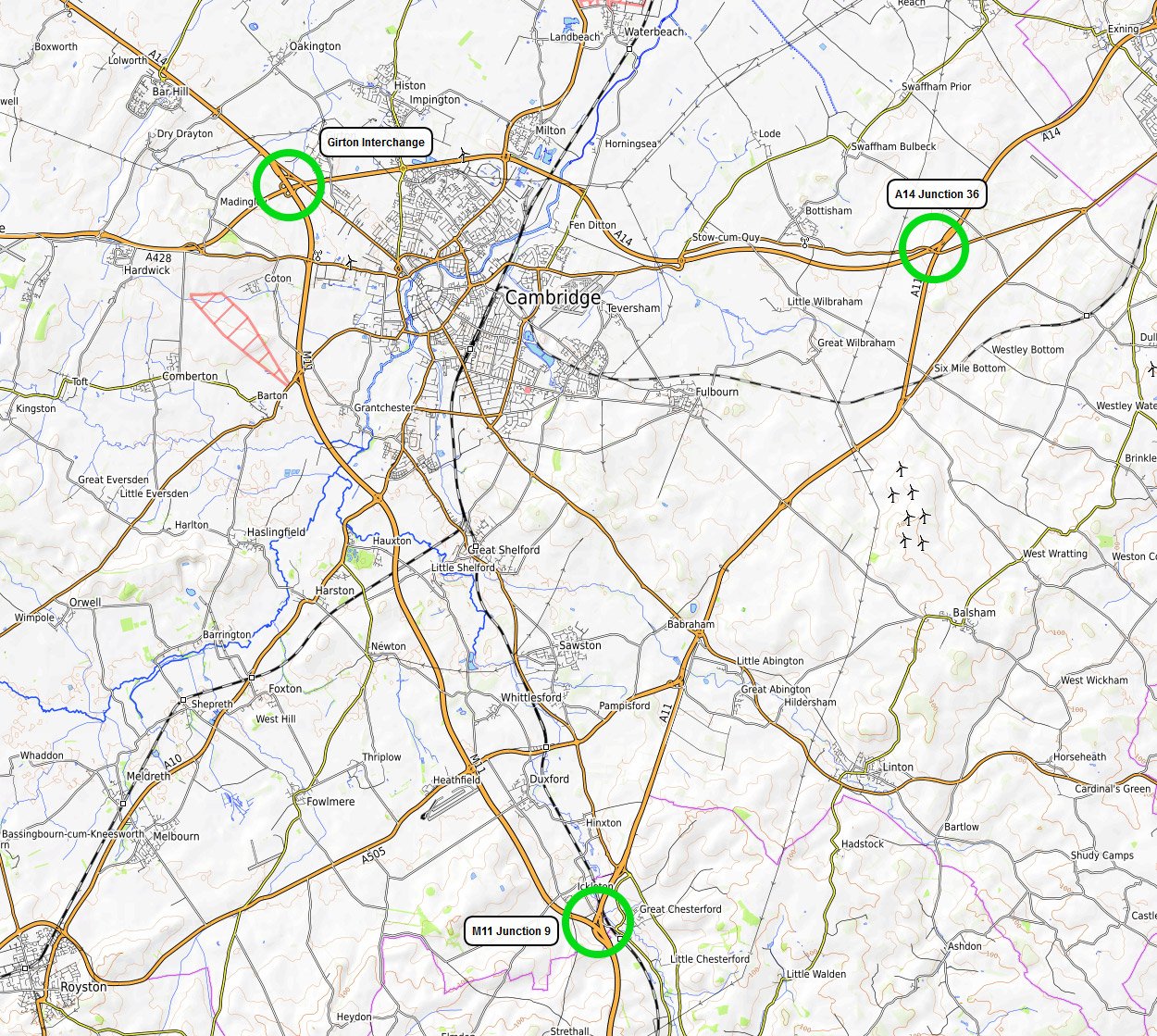The National Infrastructure Commission called for evidence in 2016/17 for its National Infrastructure Assessment. We submitted a response to Transport Q15:
What are the highest value transport investments that can be used to connect people and places, as well as transport goods, outside of a single urban area?
Overview
We would like to propose three junctions on the Strategic Road Network for consideration as high value transport investments (see map):
- A14-M11-A428 (Girton Interchange)
- M11-A11 (Junction 9)
- A14-A11 (Junction 36)
We make the case that building additional connections at these junctions would improve regional connectivity and increase resilience of the key strategic freight route between Felixstowe and the Midlands.
The A428 does not connect directly to the M11. This is where the Oxford–Cambridge and London–Stansted–Cambridge corridors should connect. The A428 also does not connect with A1307. If it did, it would provide strong support for a business case to build a Park & Ride site at the Girton Interchange.
The M11, A14 and A11 form a triangle around Cambridge. This has the potential to be a continuously-dualled outer orbital route if connections were added between the A11 and the M11 north, and between the A11 and the A14 west. It would then be possible for traffic to bypass a closure of any one side of the triangle without using local roads.
Road delays owing to roadworks, collisions and other incidents reduce the productivity of businesses that use the strategic road network, most obviously those involved in moving freight. Diverting this traffic onto local roads causes severe congestion and reduces the productivity of local businesses.
As we shift to considering transport needs in terms of mobility, we must recognise that resilience and capacity are both critical components of an efficient network.

Girton Interchange
The Girton Interchange already features in the National Infrastructure Commission’s study for the Oxford-Cambridge Expressway. We want to make sure that its potential strategic role, regionally and locally, is fully appreciated.
Even after the A14 Improvement Scheme is completed, connections at the Girton Interchange will be limited. Traffic moving between the A428 and M11 will still have to use a congested single-carriage local road (A1303). Cambridge city centre is not the only destination: traffic arriving on the A428 from Cambourne, St Neots, Bedford, Milton Keynes, Oxford, etc is also aiming for the Cambridge Biomedical Campus, the science parks south of Cambridge (Genome Campus, Babraham Research Campus, Granta Park, Chesterford Research Park), and Stansted Airport.
In other words the Oxford-Cambridge corridor needs to connect seamlessly with the London-Stansted-Cambridge corridor. This requires the Girton Interchange to be reconfigured as the critical road connector.
But there is a local need for this too: a Park & Ride at this interchange (off the A1307) could intercept traffic from the north and west of Cambridge. At the moment the choice is between driving into the city and parking (possibly for free on a residential street) or detouring 6km (to Milton) to reach the nearest Park & Ride.
A Park & Ride here also has strong potential to be a hub for a rapid transit (e.g. light rail) line connecting the Girton Interchange, Cambridge city centre, Cambridge rail station, the Biomedical Campus, and Trumpington Park & Ride. It is likely that such a line would quickly attract a ridership in excess of 10 million passenger-journeys a year. This is based on some headline figures: each year the city already welcomes 5 million tourists, 5 million arrivals at the railway station (including tourists), and over 1.5 million Park & Ride users. The Biomedical Campus is expected to see 10 million arrivals per year within fifteen years.
Design ideas for the Girton Interchange are appended.
M11 Junction 9
In theory, the A505 provides the missing link between the M11 north and A11, but this is almost entirely single-carriageway (4.3km), already heavily congested, and an important local road. It serves a number of villages (Duxford, Whittlesford, Sawston, and Pampisford) with a combined population in excess of 10,000; employment centres around the A505 and in Sawston are growing; and it is the main access route to Whittlesford Parkway rail station, with an annual footfall of 493,004 passengers (2015/16), and services to London, Stansted and Cambridge.
There is a great need for a high capacity alternative route for A14 traffic when there is an incident or road works. In the two years 2015–16, there were 24 collision incidents recorded on the section of the A14 between the M11 and A11. There were also delays owing to road works. If there were an alternative, fast route via the A11 and M11, the impact of such disruption would be greatly reduced, increasing productivity and hence GDP.
The next junction south on the M11 (Junction 8) is 22.5km away at Stansted Airport, so not a practical diversion.
The choice therefore is between bringing the A505 into the Strategic Road Network, dualling it and adding grade-separated junctions; or adding connections at the M11-A11 junction. The latter would create more extra capacity (in effect three lanes in each direction: A505 plus M11–A11) and greater resilience (two routes instead of one). The investment cost would also be lower.
A14 Junction 36
The lack of a connection between the A11 and A14 west does mean that traffic must use local roads, but the main benefit of adding a connection here would be to add resilience to the strategic road network. Closure of the northern part of the M11 (perhaps as part of future road widening) would have a greatly reduced impact if traffic could travel via the A14 and A11.
Design ideas for the Girton Interchange
These are set out in in detail in our paper, A14 Girton Interchange – a critical link.



Add comment